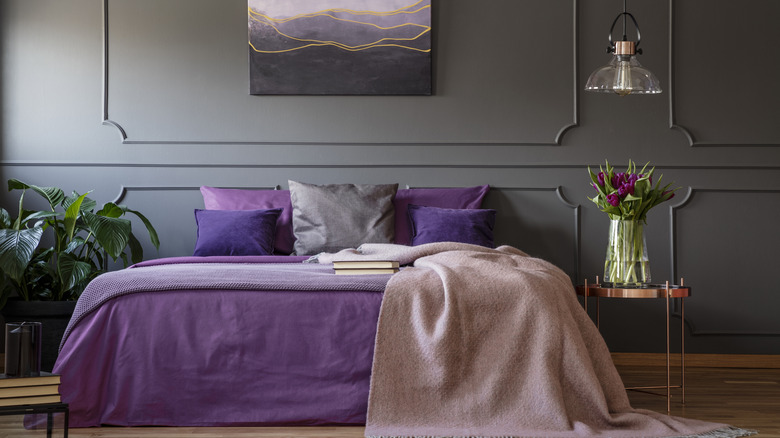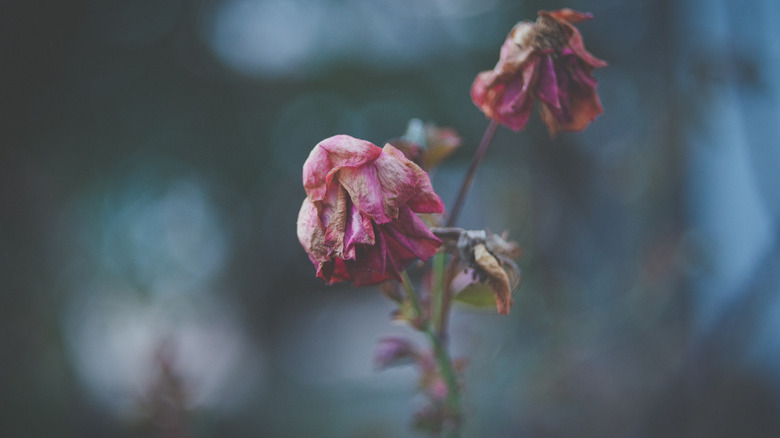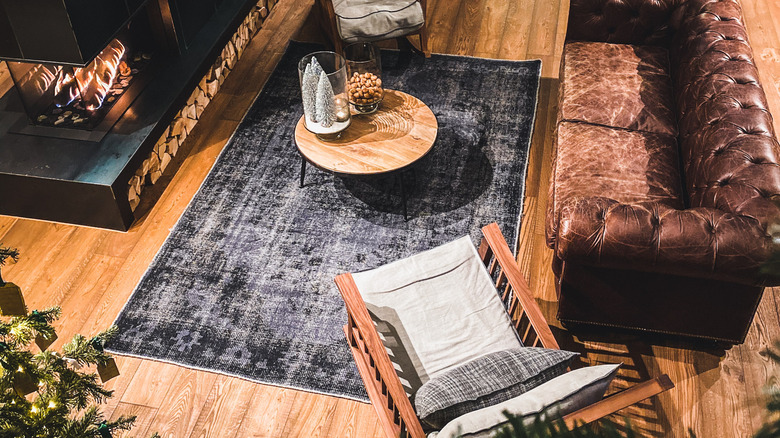The Ultimate Guide To Gothic Decor
With a gothic-themed decor, a person might imagine dramatic black drapes, skulls, dark painted walls, and heavy wood furniture. But, as with any decor preference, the vibe can be the same while the appearance is shifted. Whether you choose to keep the look completely dark or simply add dark elements, either path is sure to evoke the gothic historical heritage you desire in your home.
Gothic decor dates back to the Middle Ages, where the architecture highlighted pointed arches and cathedral-style buildings displaying iconic figures such as gargoyles, according to Love to Know. The smooth curves, simple shapes, and grand details are what makes gothic-inspired decor so despairing lovely. And the wonderful thing about this style is that you can go full-out goth, or just add gothic-inspired touches to give your home a sense of the dramatic. It's all about the details: The right colors, the best types of fabrics, and the dramatic accessories can make all the difference in achieving the gothic touch you desire.
Just add black
The obvious color choice when deciding to decorate in a gothic theme is black. You cannot go wrong by adding this shade to your home's color palette. However, you can go wrong in your approach of how you incorporate it into your space. As the saying goes, too much of a good thing is not always best. "You don't need to go all out and decorate your home all black," says decorator Ryan Jones via The Spruce.
To incorporate the gothic vibes into your room of choice, one could simply add black accent pieces throughout, on the walls, tabletops and seating areas. Be inspired by the gothic aesthetic and add elements that invoke the same desirable darkness. However, if you are looking for the space to go all out, try creating the ultimate moody experience in an office area or bedroom by creating a floor-to-ceiling all-black bookshelf display. Layer the shelves with vintage books, brass trinkets, and skulls for a genuine gothic feel.
Make a moody color palette
There are other ways to decorate in a gothic style, but with a range of colors outside of the ordinary black. Gothic decor is a whole mood, so the color palette should be the same. When using this decorative preference, the color choices are important, since you want a cohesive blend of shades across all the rooms in the house. You also want the colors you choose for your gothic look to ooze spirituality, mysticism, and creativity.
According to Bob Vila, gothic revival gained popularity during the Victorian era for home decor. This overlap of styles shares similar color patterns with blends of golds, greens, shades of coral, and bright blues. These tones allow the softer side of gothic decor to shine through, as they bring the same calming sense to the home as the darker tones do. You can find a balance in the lighter and darker hues and choose to use these shades in combination throughout your home's interior.
Create a dark accent wall with paint or wallpaper
What better way to draw the eye's attention and make a statement than by creating a dark accent wall in a living room or bedroom space of your house? Whether you choose to use a black paint or wallpaper is an independent choice that comes with parameters. To prevent oversaturation of color in a space, it is important to maintain balance of it amongst the wall and table surfaces. When deciding to create a black accent wall in your space, Homes & Gardens suggests "using the 60-30-10 rule."
This tried-and-true decorating technique allows a person to create an ideal blend of color in their space by keeping the respective ratios: the main color should be about 60% displayed, while 30% is adjacent background colors, leaving the remaining 10% for accents. If the accent wall is a bold, dark shade, then incorporate similar tones throughout the space in other elements to tie the look together.
Add wall crowns and moldings
When you read the terms "Victorian" and "gothic," images of large arched cathedral style castles should come to mind — or the Addams family home. What the two have in common are the structural and architectural accents that inspire gothic decor. The carvings and moldings throughout the designs are a structural feature sure to invoke the ultimate gothic vibes in your home, as illustrated in the image above.
To achieve this at home, one could add elegance and texture to a dark color scheme by adding wall molding. You could add these moldings to tops and bases of a wall or create a decorative design across the wall. This dimensional feature will magnify a flat surface's impact in a room. According to HGTV, installing moldings, including crown molding, isn't overly difficult, but you do need a few basic tools. Be sure to keep accurate measurements and angles as you want a seamless finish.
Mix in and update for elegant looking furnishings
The ultimate gothic decor is not complete without the right tables, chairs, and stands to furnish the rooms. Furniture pieces with intricate details and dark color tones add character to the room in a way a rug, curtains, or small tabletop accent pieces simply cannot. When choosing furniture pieces to add into your home, try to source furniture items that are representative of the time period.
For a genuine gothic-inspired look, try to find heavy furniture with arched and spiral designs, according to Impressive Interior Design. These curvatures mimic the once-popular architectural features. The curves, grooves, and slopes also introduce elegant movement into the space without the additional elements present. Updating existing furniture is a favorable option as well, as it is not only cost-effective but can be fitted to align with the design mold. One could find a new set of knobs, pulls, or legs for most furniture items to give them a quick, easy update. These accents can be purchased in numerous finishes from brass or silver to antique gold, sure to fit in with your desired gothic style.
Dramatic draperies for the windows
Filter out the light and execute elegance by adding heavy drapes to the windows in your home. Curtains that have a "heavy" appearance are ideal for gothic decor, as the dense weight of the drapes creates a dramatic look over the windows. The gloomy, ultra-luxe vibe that is created from using this style of draperies is what you need for a gothic-inspired room.
For a full coverage look, Williams Sonoma advises multiplying the width of the window by three. Accurate measurements are important, since you want to be sure to hang the curtain rod the appropriate distance from the window frame. With the measurements for your windows complete, you are ready to choose the lush fabric fit for your space. Insulated blackout curtains can be a wise decorative decision, as they have an additional layer that helps add to a window panel's voluminous appearance. You can even try to layer curtains on one rod or use a multi-rod system for more curtain coverage. Curtain color choice for a gothic-inspired design should be consistent with the dark shades common to the overall style.
Incorporate items with ornate features
Since gothic decor overlaps Victorian-era style, the vintage vibes are an attractive element in this decor scheme. According to Matt Cameron, ornate details are critical elements in gothic decor, but are less ostentatious than Victorian-inspired pieces. How do you add these old pieces to your home? If you cannot find the aged furniture item you need for the look, or one fit for your space, you can try to tap into your creativity and thrift an old dresser or table. This is the perfect way to incorporate vintage into the home because you can make the old furniture piece anything you want and have it painted to be any color you want.
If you are less inclined to DIY anything, keep the contemporary style furniture you have, but bring in that vintage feel with your accessories, such as adding a mirror with ornate embellishments on the edges. This pairing of something old with something newer is perfect for creating a modern gothic interior.
Display dried flowers
What was once beautiful alive can still be beautiful in the afterlife. Instead of a fresh bouquet of seasonal flower favorites in a vase on your kitchen counter or dining room table, one could opt to display a dried arrangement of flowers in those same spaces. "Dried flowers have a beautiful texture and architectural structure, as well as being wonderfully long lived," advises floral designer Layla Robinson via Homes & Gardens. They are also a favorite for decorating in a gothic style home.
Dried flowers are heavily romantic, and are stunningly gorgeous in a vase on a console table in the home. They are significantly low-maintenance, but highly delicate so arrangements should be catered to with care. The wrinkled and faded rose petals with darkened stems are attractive tones to add to a gothic theme, as they instantly make the aesthetic have more depth. They also help introduce a ton of personal experience as the arrangement could be a treasured gift from a loved one.
Ambient lighting on the walls and ceilings
For the ultimate mood-setting accent, one could choose to amp up their gothic vibe by decorating with light fixtures that blend with the aesthetic. To introduce vintage elegance into your dark domain, you could hang a crystal or dark metal chandelier from the ceiling in a bedroom, walk-in closet, or dining room. For a truly radiant statement light, consider adding candle wall sconces in the hallways or bedrooms. These sconces can vary in style and features, with some displaying glass enclosures and others none.
The variety of sconce style is one decision, and the candle shape is another important consideration. When choosing a style of wall sconce, one should be conscious of the base the candle will sit on, recommends SFGate. Some will only work with a certain type of candle, such as a taper candle, while others have flat bases that are appropriate for pillar candles or tealights. Those with a flat base may be desirable, because this style is great for those decorators who want to change up the look or swap candles seasonally.
Table lamps are a great artificial light source and can be easily added to console tables and nightstands. One could consider dressing a lamp shade by draping a thin, dark fabric over it for the ultimate luminescent gloom.
Delicate, dark wall art
Art is an attractive decorative medium, as it is versatile and transitional for any home decor style. You can find art fit for your preferences, including art for gothic-themed homes. If you are trying to fill in wall space and need an idea less permanent, but still dramatic, you may want to consider adding dark wall art to your home. Bring the dark vibes alive by introducing gothic-inspired tapestries, canvas paintings, and purchased prints with images in dark shades of black, green or red.
Use these deep tones in your space on the walls by displaying images of red roses, skulls and skeletons and even delicate flowers. One should source art and prints with colors that exist in the room as this will help unite the pieces. Architectural Digest recommends that you don't just choose any art, however. It should speak to you on a personal level, so that it has meaning in addition to working well with your decor.
Choose dark rug tones and patterns
If bringing darkness into your space cannot be done on the walls, and you need a more temporary dark addition, one could try adding a rug with deep hues to the floor space in their home. A decorator can make a dynamic statement by choosing to decorate a space with a black rug, according to Homedit. This specific element is not only elegant, but powerful when used appropriately in an area. You can try to slide the accent area rug underneath a sofa or bed, or try to line a hallway or entryway.
Decorating with rugs is helpful in creating definitive paths in the home. They also help section off rooms from one another, as well as elevate the look of a furniture piece. In some cases, such as in the hallways, they can help guide and lead a person's direction. Not all rugs need to be a solid color, though; this is a great opportunity to show your uniqueness by adding one with a complementary pattern. Rugs with flowers, gothic motifs, and vintage markings would be some designs to consider to bring the ultimate gothic decor to your house.
Incorporate soft textures and fabrics for balance
For a successful gothic-inspired decorative scheme in your home to come to life, the inclusion of ultra-plush elements is necessary. Accent items such as ottomans, throws, and pillows can be the missing elements in your domain as these traditionally soft decorative pieces are ideal to incorporate to help maintain balance. As these items are commonly crafted of lavish fabrics such as velvet, chenille, cotton, and silk, they are ideal textures to provide the coziest comfort for the guests in your home.
Velvet is a desirable fabric choice when decorating a home, as it is "soft and curvy," says designer India Mahdavi for House & Garden. This plush material is perfect for a gothic-inspired look, as the softness of the velvet helps balance the hard elements. You can accent the main rooms in your space with heavily-draped blankets, or lay throws across bed ends and over baskets. You can even pair a vintage accent chair with a tufted ottoman, or add additional softness to the sofa with oversized pillows. A genuine cohesion is achieved when there is a balance of the sharp and subdued textures in a room.
Statues and skulls
For the ultimate gothic-themed look, the next decorative idea is an iconic must-have element: Skulls. Lean into the goth feel, and incorporate this edgy element in a sophisticated and stylish way throughout your house. Choose your favorite skull replica as seen in the above image, and place it on a stack of books, on a tray on a coffee table, or next to a vase in an entryway. If placing a skull directly on the mantel is not quite your style, one could incorporate skull decor into the home by using the motif in other elements like skull-shaped vases or embroidered pillows with skull patterns.
You could also try some DIY projects to create decorative bookends, as per Curbly. Decorating with skull accents is such a cool way to introduce a moody vibe into a room. To complete the gothic theme in your home, incorporate a skull accent for an unexpected contrast in your space.
Mix metal, stone, and wood accents
Mixing wood features, stone textures, and metal elements will introduce a castle-like atmosphere perfect for achieving a gothic-inspired design in your home. Mixing these features is easy when you concentrate on the variety of pieces in the same room, such as the coffee tables, chairs, ottomans, and end tables, to name a few. These furniture pieces are often crafted from fine woods and durable metals adorned with metallic, stone, or marble accents. Decorating with furnishings that have these attributes will add a natural dimension to the design.
If furniture pieces are not required, one could incorporate wooden ceiling beams or surround a fireplace with stone. If you cannot put up real stone, you could try to create a temporary look in your home by choosing to create a faux stone effect on your walls or near a fireplace for the ideal castle vibes, as per SFGate. Whether you want to introduce a full-on dark, decadent look, or simply add some themed elements, you can find ways to incorporate the ultimate gothic aesthetic into your home.














